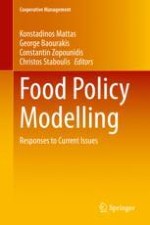2022 | OriginalPaper | Chapter
4. Countries’ Image and Agricultural Trade Volume
Authors : Christos Staboulis, Dimitrios Natos, Efthimia Tsakiridou, Konstadinos Mattas
Published in: Food Policy Modelling
Publisher: Springer International Publishing
Activate our intelligent search to find suitable subject content or patents.
Select sections of text to find matching patents with Artificial Intelligence. powered by
Select sections of text to find additional relevant content using AI-assisted search. powered by
